(Under continuing construction)
FLOWERS and TREES
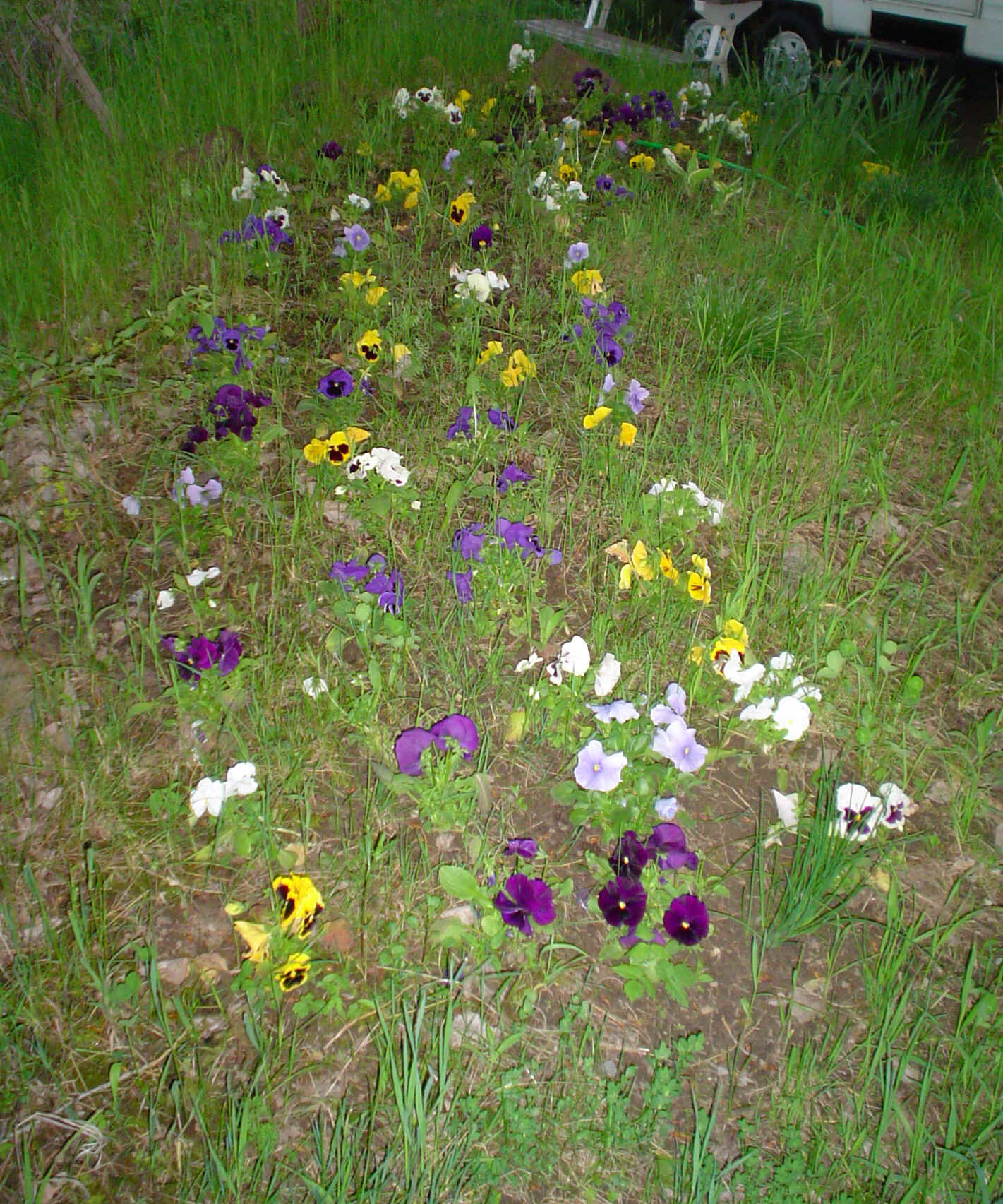
Planted
Pansies on a made hill
Nasturtiums blooming in early May

Coleus
growing in shade along sidewalk at front of house
The
front yard has many perennials like these Hydrangea

Lilac
bushes were planted on the side of the house

Dandelions
predominate in early May
Planted
Black Locust trees in bloom
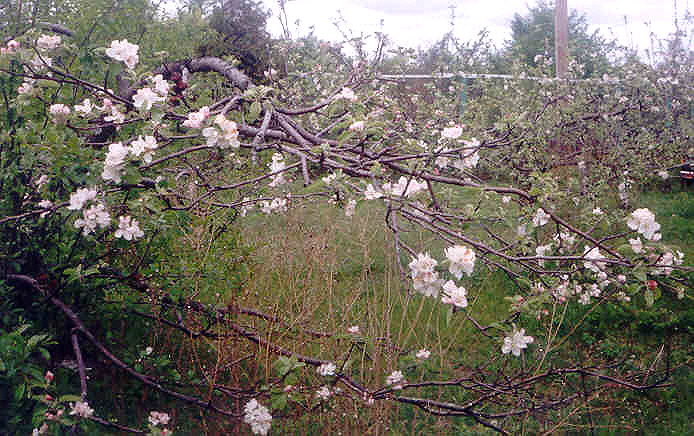
Apple
blossoms abound in May
Planted
Comfrey growing around base of barn in the Spring
Fancy
Irises
Yellow
Irises
Planted
Peony
Large
Honey Dew Bush in front of house.

Scarlet
maple trees in Autumn lit up by a bright sunset
Crops

My
grand daughter, April, sitting between two giant pumpkins at Cedar Ridge
Orchard.
A
new crop of laying hens being kept warm
Vegetable
garden
Honey
production
Raspberry
production
Ponds
In some years, I set up a fish pond in a dug cavity in the front yard that is over 3 feet
deep.
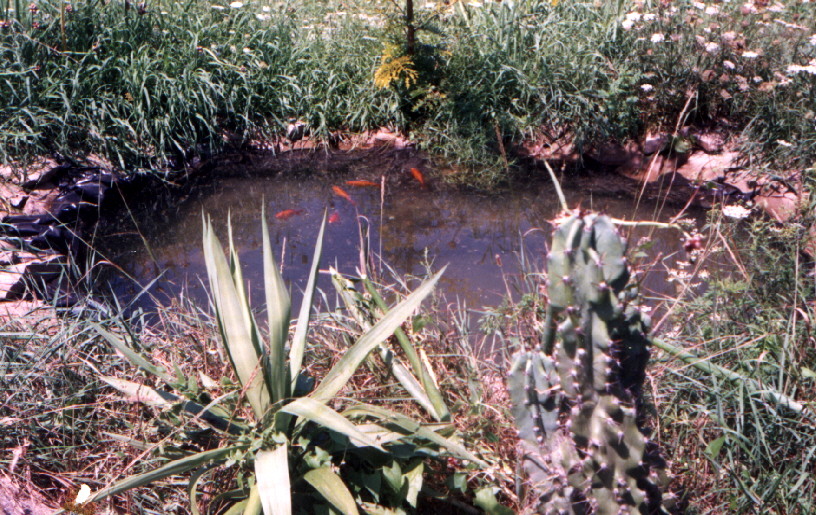
Year-round pond with fountain
There is a large seasonal pond on the property that is about 70 feet across and about 3 feet deep at the deepest end. I have raised some fish in it, but the Blue herons and marsh birds have come up from the swamp and wiped them out on me. Also, the pond will not hold water during periods of draught, and the well can not stand the constant drain of water flowing in a hose to keep it wet. Therefore, now, I let it dry out after the salamander newts, and the frog and toad tadpoles leave the water.
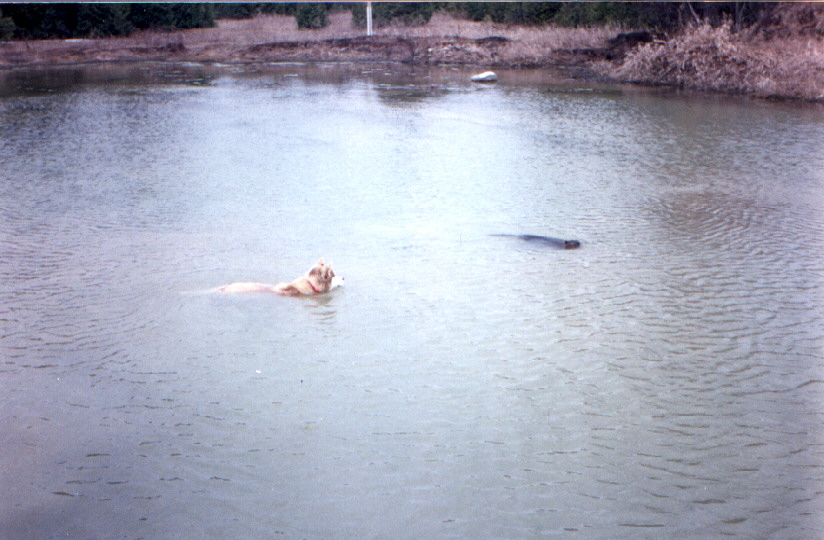
One Spring, I noticed Red Flame sitting over by the pond watching a beaver that had come
up from the swamp. She was fascinated with it and watched it for days.
Finally, she jumped in the water and began to chase it, but the wily beaver was too quick
for her.

Solarium
In 2001/2002, I built a 9.5' by 6' solarium including a 48" deep by 6' long by 3' wide cement fish pond. I stocked it with 6 Koi Carp and 12 Goldfish. It is a relaxing place to go read a newspaper or just watch the antics of the fishes, no matter what the weather is like outside..

Feeding time in the solarium pool
This inside cement pool is 6' long by 3' wide by 4' deep, and is lined
thrughout with
black epoxy paint
to give the illusion of an infinite depth. It is ice-free all year.

Aw,
come
out and play guys.
Feeding the Wild Birds , and squirrels
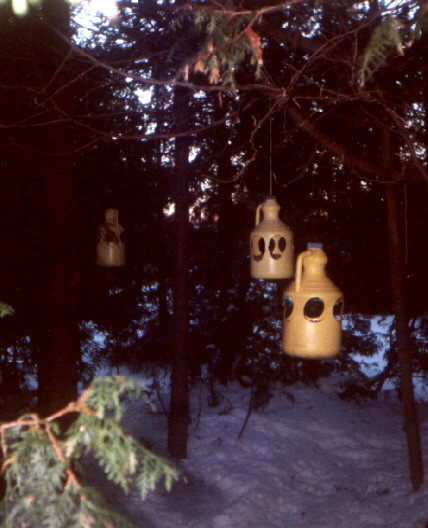
Old fashioned Javel water jugs (with the spouts at the centre) make
excellent feeders. I cut six each two inch diameter holes around the sides for
entrances.
I find they have to be replenished every few days.
I have noticed that Cottontail rabbits and Varying Hares come around and inspect the
ground for any spare droppings. The birds are very 'messy' eaters and drop more than
they eat..
I have never seen any 'flying squirrels around here, but friends in Timmins, much farther
north, see them at their feeders.
It took some patience to finally get a photo of this little fellow peaking out of the feeder where he would show up in a picture.

Cats
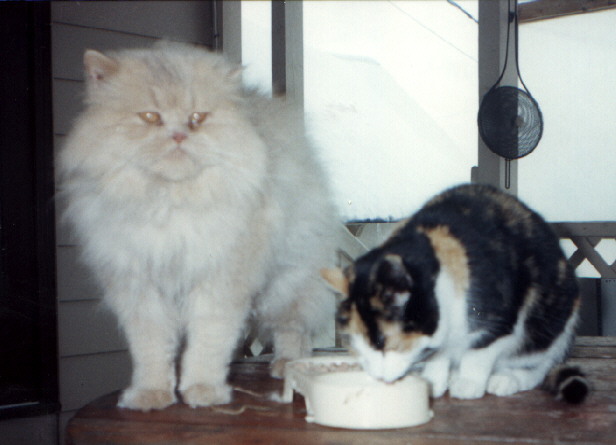
Our two cats; Honey and Muffin. Muffin was a tortoise
shell neutered female and Honey was a Persian male. Both are deceased now.
Muffin had been across Canada twice, once by airplane, and once by automobile.
Honey belonged to Diana, I was 'baby sitting' him for a couple of years.
Although he looked quite docile, he could take care of himself in a cat fight. He
used to occasionally visit a farm barn across the road to see some feline girl friends.
Pigs

We had two Yorkshire pigs for our own use. It is better to buy meat when one
knows what the animal was fed these days.
They were quite docile once they got used to me and their new home. I found they would produce tremendous body heat & would warm up the inside of their building with no need for electric heaters.
They were very fastidious animals, and kept their bodies very clean. This photo was taken
when they were about 100 lbs.
They were marketed at about 250 lbs.
Wild Boar
We have about 12 - 30 boars at any one time.
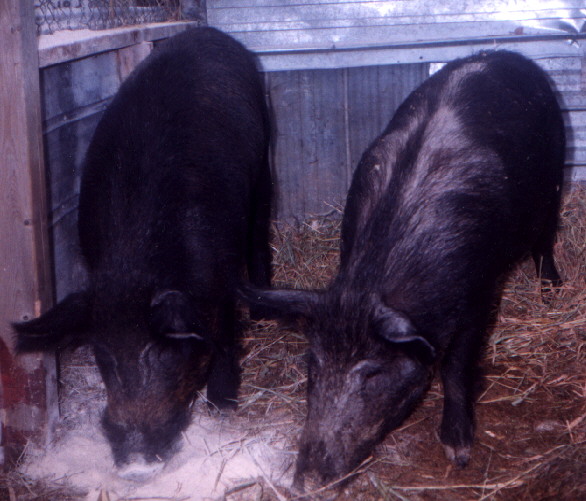
We started with two European wild boars that were taken by the SPCA from an
abusive situation. They both appeared healthy. The female is pregnant, and we are
looking forward to watching her babies grow. I think, by her condition, she will
have them in April, which seems to be the natural time of year for northern forest animals
to birth. The male is the boss, but is not mean to her. Regardless, I will
separate them when the birthing time arrives. They eat 'mixed chop' grain (which is
ground up very fine) and occasionally, some vegetable scraps I manage to obtain from a
local grocer. I was told they have never been separated, so I will have to be
careful when keeping him away from her during birthing, (and for awhile afterwards.)
The male is quite protective of the sow and will not hesitate to protect her if he
thinks she is threatened. Here, he is standing in front and she is partially hidden
behind him.
These fellows are the ancestors of our barnyard pigs, and are found in the wild
in Europe, and as far east as Siberia, where they are hunted by Siberian Tigers
and Wolves.

Unlike their parents, baby
wild boars are born red with black stripes. In the first year, they lose
most of the redness and it fades to black. Their mother is very possessive
and will not stand for other boars tormenting them.
The females will eat other mothers' babies so expectant mothers have to be separated from the others before giving birth.
Unlike domestic pigs, boars have only three or four piglets at a time and that is it.
Surprisingly, the old boar does not bother the young ones and they actually seek his company when the entire group is eating as they know from experience that he will not hurt them.
On cold nights, the large male boar goes to his favourite dug hole and lies in it, then about five other boars will come and lie on him to share the warmth. On some winter mornings,
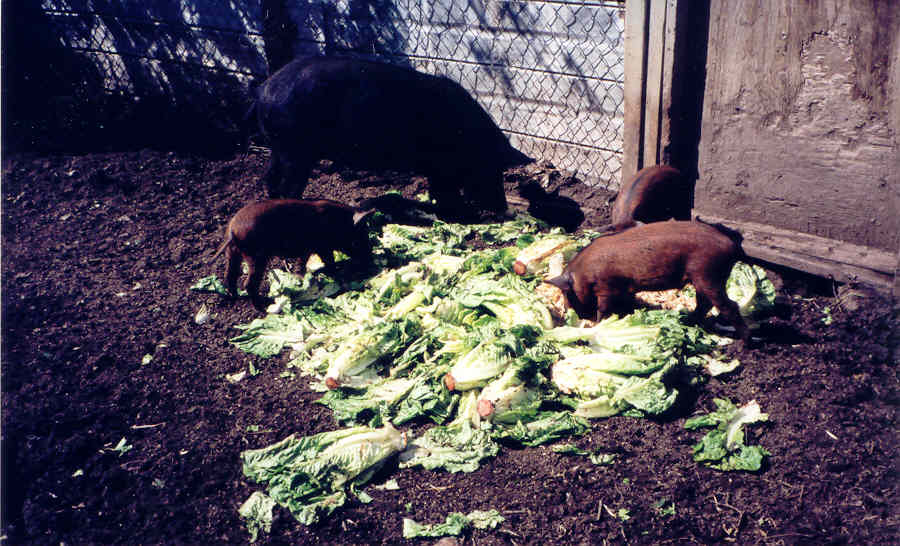 all one sees is a large mound of snow until they stir and shake the snow off.
all one sees is a large mound of snow until they stir and shake the snow off.
Another mother and some triplets this time. I keep each litter separate from others until they can look after themselves.
Their most dangerous antagonists are the other mothers, who have no time for them. Mixing them too soon with the regular herd will result in scratches and perhaps more serious injuries.
A
group of four wild boar piglets wandering around the property at will.
Vietnamese Pot-bellied Pigs
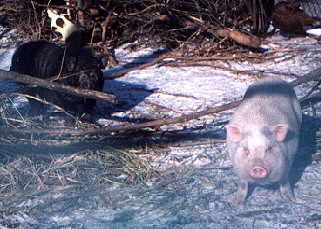 These are quite mischievous and intelligent animals, although they have the typical pig
attributes of stubbornness and a penchant for getting into trouble.
These are quite mischievous and intelligent animals, although they have the typical pig
attributes of stubbornness and a penchant for getting into trouble.
Once they experience something, they remember it for the rest of their lives.
This is 'Blanche' and friend, who lived on the farm for awhile.
There is another white one now living with the sheep and
goats. Her name is "Blanche" also.
Sheep, Goats (&
Geese)
We have 16 goats and 15 sheep at this time.


Betty was a Nubian Goat, and was quite set in her ways. She died at 15 in human years.
Like all adult goats. she did not hesitate to use her head to push others out of the way when feeding in a
crowd.
There now are two purebred bucks running with the herd. They are 'Billy',
the Nubian, and 'Roy', the Canadian Boer.
The eventual aim is to have an entire 'Canadian Boer' herd, as it would be the best choice for meat goats.

Goat kids love to play king of the castle on an obliging Highland Cow's back
I've seen as many as three at a time up there
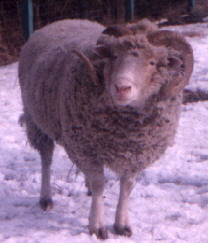
This fellow has a huge battering ram for a head. And he knows how to use it. He is a 5 year old horned Dorset. He has to be watched by anyone venturing into his space, especially during rutting season. Even Betty the goat gives him space.
He is called "Rambut" and is the undisputed 'boss' of his herd.
He belongs to my daughter Tanya and her partner, Chris.

Now remember, follow me and stay in a single file
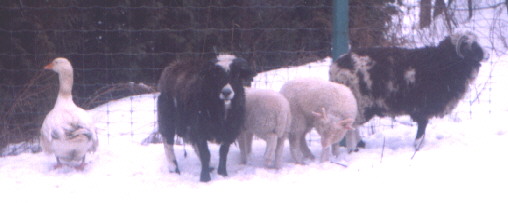
Cattle
This
is Newton, a proud purebred Scottish Highland bull.

This is
Heather, a Highland cow, cleaning up her first born calf, Hester
Hester is
now larger than Heather.
2006
crop of Highland cattle, Hester (b:14 Feb), Shamus (b: 29 March) and Snowflake
(b: 06 June)
(Snowflake is pure white with blue eyes.)
Reforestation
A lot of work has been done to plant trees and other plants on the
property. About 500 Red Pine, 200 White Cedar, 100 Black Locust, 50 Hybrid Poplars, and
several kinds of decorative plants have been started. There are now about 10
thriving Asparagus plants in the back yard and near the south-west side of the barn, where
they will be protected from an northern winds. Cat-tails have been planted in and around
the pond and an artificial swamp near the bird enclosures. Weeping willows have been
replanted at the pond side.
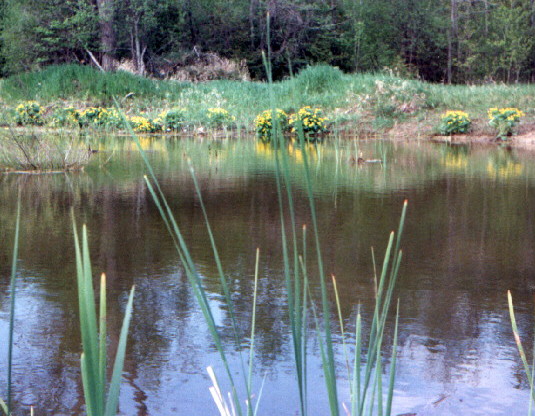
Marsh Marigolds transplanted to the large pond from a swampy area about a mile away
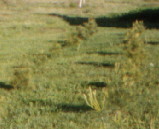
There are about 14 Colorado Blue Spruce planted at the front on the eastern side. They are fairly slow growing so it will be quite a few years before they can be enjoyed in their full maturity.
During a dry summer, I have to ensure they get enough water.

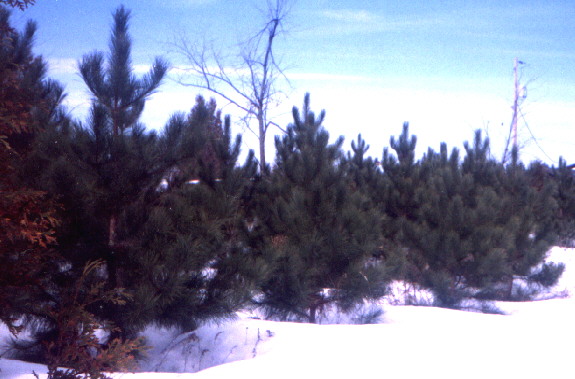
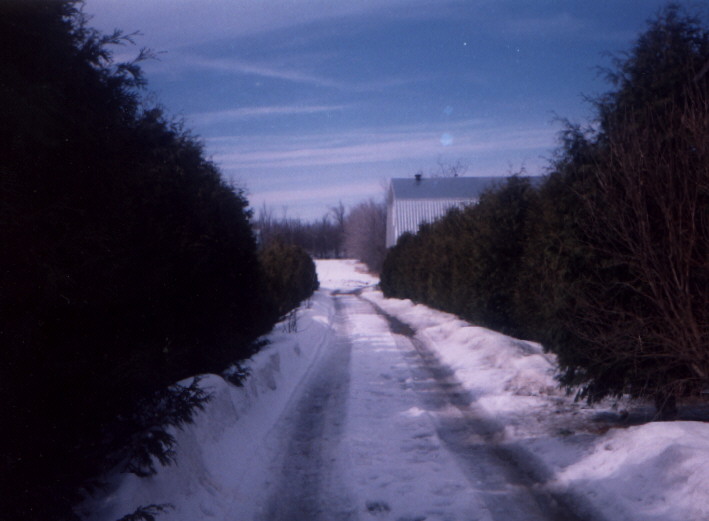
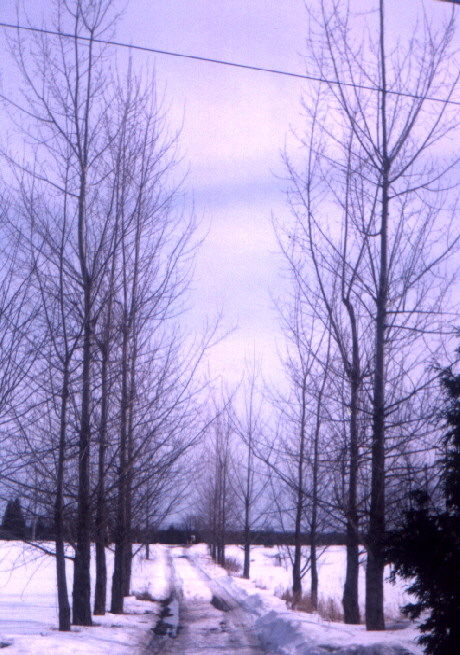
These trees were developed by the Ontario Dept of Natural
Resources to grow very quickly. They are only about eight years old and are
already over forty feet high
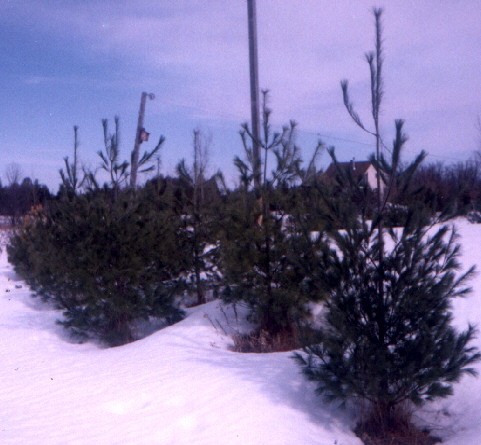
Land Reclamation
When I first came here in July of 1990, I found several areas where there was refuse, glass, cement, wood, etc. dumped. Those areas were devoid of any life and were a scar on the landscape, so I cleaned them all up and planted grass. There also was a large trench scrapped down to bedrock about a hundred feet long and about fifteen feet wide. It was very unsightly, so over the years, I have been filling it in with soil, animal manure, and ashes, etc. I left an area about forty feet long for an 'artificial' swamp to plant cattails, loose-strife, and other marshy plants. It is a good substitute for a pond during the summer months, as I can keep it partially filled with water. It has a lot of cover, so frogs, toads, snakes, etc. are to be found there..
I dug a drainage ditch down to bed rock and about three hundred feet long down at the lowest level of the property so it would not flood every Spring.
Wildlife
There are abundant white tail deer herds in this vicinity.
It is not uncommon to see one or more deer munching on the grass or buds in one of our
back fields. I have seen some come to within about fifty feet of the main
barn. One particular doe has set up a home range in our 'hardwoods', where she
regularly raises a fawn or two every year.
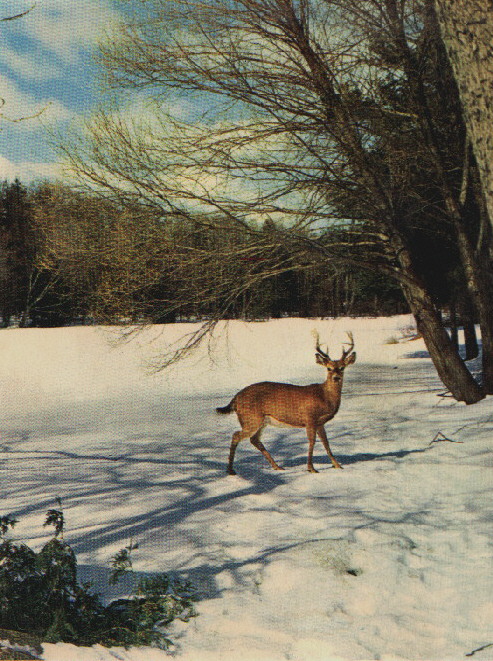
Three white tail deer grazing in the outside field at 8:PM.

This is "Bambi", a young doe that was hit by a motor vehicle near here and suffered shock and a possible concussion.. She was brought to me to dispatch, but I thought she could be saved. I had a veterinarian come and examine her and he said she had no obvious broken bones.
After three days of recuperation, she appeared to be improving so she was
taken back to where her mother had been seen looking for her. We saw her
again in the company of her mother, so I am fairly certain she is doing okay.
An unfortunate accident that had a happy ending.
Exotics

There are about fifty tropical plants which are
taken outside in May and are brought inside in September. They
range from about thirty Amaryllis (started from seed) to several Jade bushes, three large
"Corn plants", a large Cactus, and several others.
The Cactus has only bloomed once, and that was very special. The bloom came
out at night and withered up when daylight returned.
I had no idea that a plant that appeared so ugly and hostile could produce such an exquisite flower.
I have been successful in producing Amaryllis from seeds. I use a small paint brush and pollinate the flowers with accumulated pollen I save in a small container.
During four to five months of the year, there are tropical plants temporarily 'planted' in the front of the property to brighten it up and to see what response visitors will have.
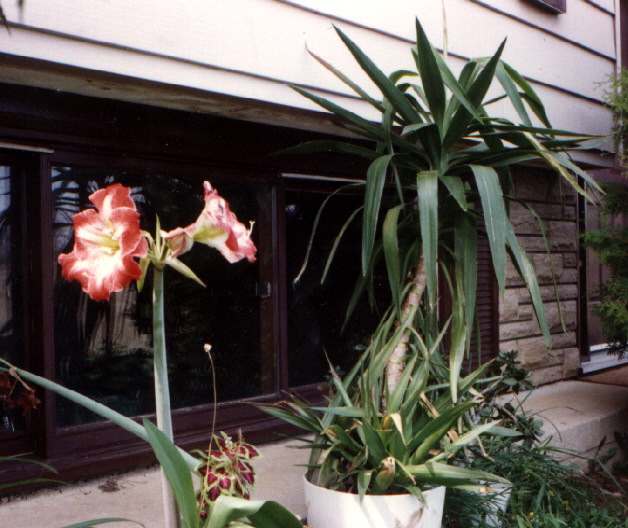
Amaryllis
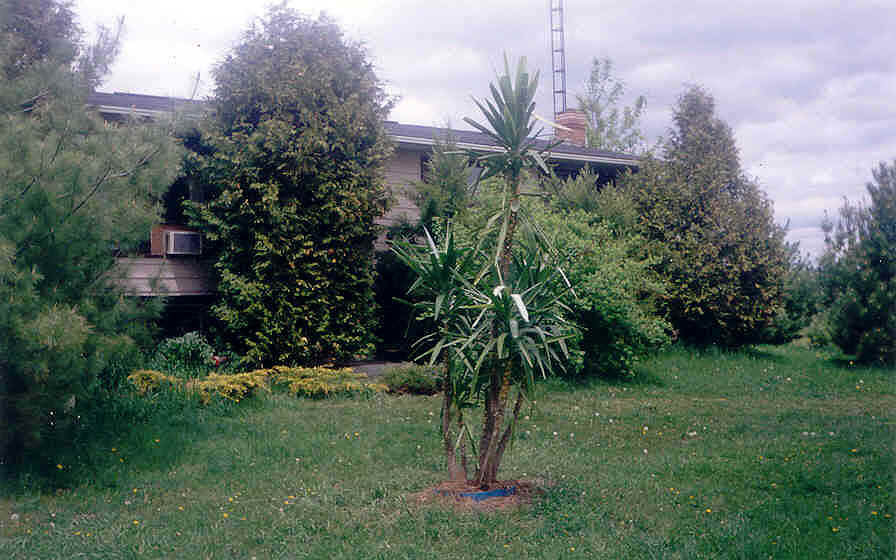
During
the warmer months, Yucca trees are brought outside.

The large Yucca tree during winter storage
Woodland Trails
Several walking trails have been cut through the
hardwoods area and are marked in colour-coded paint. Stones and rocks have been
removed from the trail areas, and all cut brush and rubbish has been removed. The
trails are kept clean with the powered lawn mower every year. There is a resident
population of several Cotton tail rabbits, a few Varying Hares, several families of Red
Squirrels, and some Grey Squirrels on our property. There is a White Tail doe deer
that regularly raises a fawn or two at the northeast wooded area of the farm. I
don't allow any hunting here.
Some Scenes Around The Farm

(Aerial View)
Fog Rolling up from the swamp on a cold evening
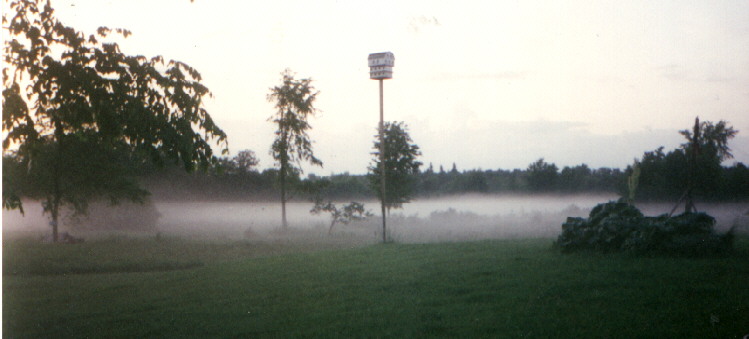
Winter Scenery
Front View of house in February

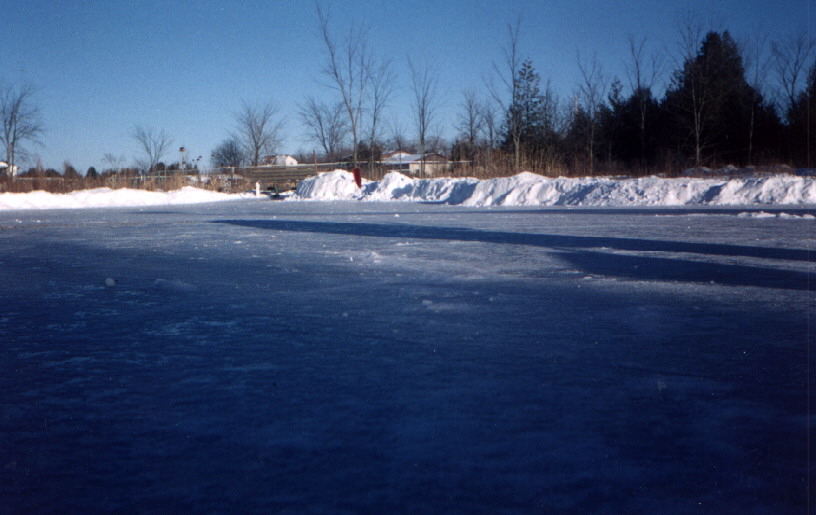
Ice Rink created by scrapping snow off pond
Front of barn after a snow storm